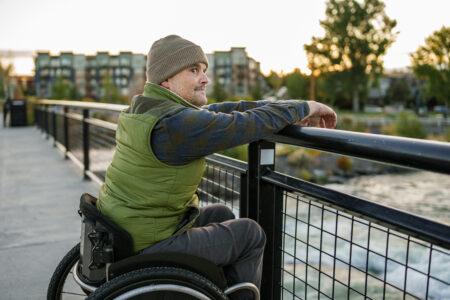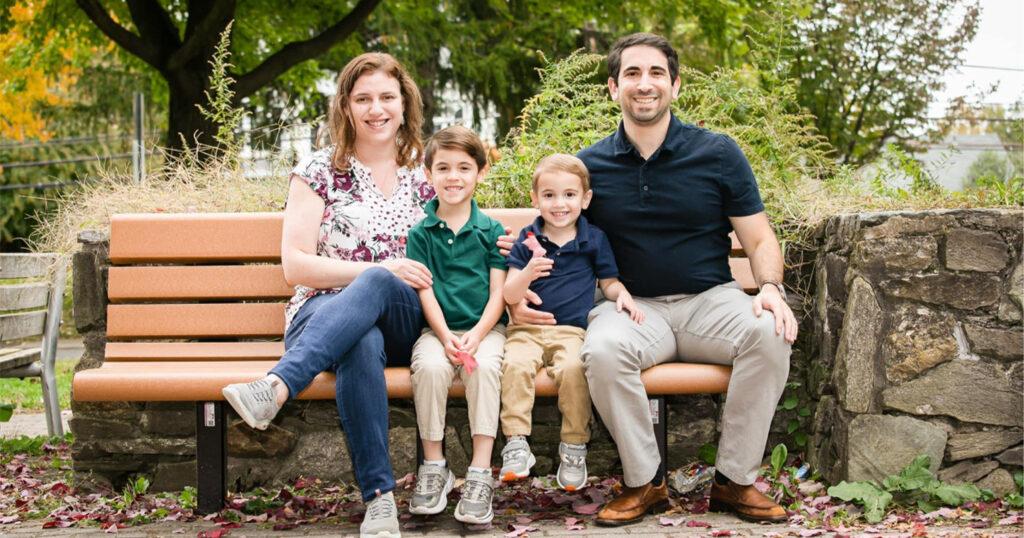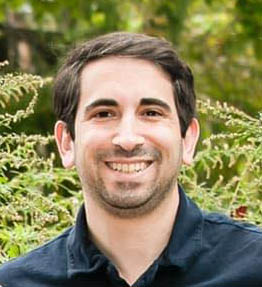Our Director of Advocacy & Policy Stephen Lieberman spoke at his synagogue for Jewish Disability Awareness, Acceptance, and Inclusion Month (JDAIM). “I charted both my own personal journey of identity and the journey our broader society must take when it comes to disability — from awareness to acceptance, to inclusion, and finally to pride,” says Steve.
Following is the video and the text of his powerful speech.
Shabbat shalom.
Thank you, Rabbis Harris and Megdal, for giving me the opportunity to speak this morning. Our conversations over the past few months have been earnest and purposeful as we look to ensure that this congregation embraces the notion that our community members with disabilities are welcomed and feel that their needs are heard and met.
February is annually recognized within organized Judaism in the United States as Jewish Disability Awareness, Acceptance, and Inclusion Month. This is a bit of a mouthful. It’s also, in my opinion, not enough. What does it truly mean to celebrate our disabled friends, family, coworkers, and neighbors? I’d like to take you on a journey – a journey of disability identity. This is not just a communal journey, but a personal one as well.
When it comes to any difference – one of language, ethnic background, religion, or health status – we begin our understanding through awareness. What is awareness? It’s education, learning, and an attempt to understand something new. Awareness is important, but it’s just the first step.
Awareness is a life-long journey
From a young age, I was aware that I wasn’t, well… typical. I was a very smart kid but had trouble relating to my peers. Social cues were definitely not my strong suit. Middle school and high school were isolating experiences. Eventually, at 16 years old, I was formally diagnosed as an autistic person. This was a life-changing moment for me – a moment of clarity that allowed me to finally begin understanding myself – but this was just the beginning of the journey.
Awareness is both that initial understanding as well as continual learning. There are many things we aren’t aware of until we start paying attention to them. For example, did you know that more than a quarter of Americans have at least one disability? Disabled Americans are the single largest minority group in the United States. Disability status cuts across every demographic category – age, race, gender, you name it. It’s the only demographic group that any one of us at any time could join in an instant.
People with disabilities face persistent barriers in accessing housing, employment, and health care services. Did you know that most wheelchair users go years without being weighed because their doctors don’t have weight scales that are accessible?
And yet, when it comes to disability, you still find all kinds of pushback in our society. We can be as aware as we can be, but awareness without action leaves all the barriers that disabled people have faced forever firmly in place. This is why awareness is not enough. This brings us to acceptance.
Acceptance means taking that knowledge gleaned from awareness and internalizing it, making it real, and understanding that it isn’t something that’s just magically going to go away. A lack of acceptance is something that I feel is particularly acute in the autism world and has unfortunately birthed destructive social paradigms such as the anti-vaccine movement.
We need space to take risks and try new things

After I was formally diagnosed, I was uprooted from my high school and sent to a brand-new boarding school for students with nonverbal learning disabilities. I was reeling from the whiplash to my identity, didn’t want to be there, thrust into not just a new environment for me but a new environment for everyone there. It was its first year of existence and not only was I seeking to discover myself, but that entire ecosystem was seeking to find its footing.
A funny thing happened. Being in an environment where everyone was similarly seeking to find themselves made it a whole lot easier for us to take risks and try new things. There wasn’t that feeling of judgment from neurotypical people when you didn’t get a social interaction completely right. For myself, certainly, it was the beginning of coming to terms with who I am – my strengths and weaknesses, the things that make me an individual.
It took me years to incorporate my autistic and disability identity and accept it as fully a part of me. In that time, I went to college, met my wife, and started working on Capitol Hill. It was around that same time that activism around disability, and around autism in particular, began to shift from awareness to acceptance.
Avoid euphemisms and #saytheword disabled
Let’s face it – for too many of us for far too long, disability has made them uncomfortable, to the point where people have gone to absurd lengths to invent words so they don’t have to actually say “disability.” You know what I’m talking about – “special needs,” “differently abled,” and so on. I’m here to tell you that it’s ok to say the word “disabled.” The effect that these invented words have created has been to infantilize people – to create a series of stigmas around disabled people that give rise to a series of false and hurtful assumptions. For example, a doctor treating a wheelchair user talking to their patient’s spouse instead of their patient. A sales clerk talking in a raised voice to a blind customer. The many, many barriers to employment for people with disabilities.
For autistic people in particular, there are an incredible number of false, yet pervasive assumptions, some of which I feel have been spread further by poor media representation. For many years, the conversation around autism seemed to revolve solely around children, as if when we turn 18, we vanish in a puff of smoke. Autistic people have been represented as monotone, emotionless, and unable to have relationships with neurotypical people.
We talk about an autism spectrum, but too many wrongfully assume that this spectrum exists in one dimension, like a line that goes from “mild” to “severe.” This is incorrect. Picture a color wheel, with an infinite number of gradients of the many colors our eyes can see. Autism is as varied as the human condition – unique in each of us.
Disability is a natural part of the human condition
I will make it clear that I use the term autistic person as opposed to person with autism, and I will explain why. Autism is a part of who I am and how my brain works. It cannot be separated from me. I cannot take autism, place it on this lectern and leave it here while I go take my son to basketball practice. Therefore, I cannot be “with” autism; by definition, I am an autistic person. It is intrinsic not only to my existence but to my identity. Autism is also, indeed, a disability. I define it as a sensory/social disability. It took me a number of years to accept that, but that acceptance was critical to me truly becoming a complete person.
Similarly, it is critical that we accept disability as a natural part of the human condition. In this way, we find similarities to the LGBTQ+ community. This is who we are. No amount of wishing it away is going to change it. There’s no magic wand to wave to give a blind person 20/20 vision or to heal every spinal cord injury. We have to get away from the medical model of disability, which supposes that disabled people must be “fixed,” and embrace the social model – that we as a society should work to tear down the collective barriers imposed on disabled people.
Once we resolve to work to tear down those barriers and stop trying to “fix” disabled people, then we’ve reached acceptance. But acceptance is not enough. This brings us to inclusion.
Inclusion means ensuring there are no barriers to equal opportunity
Inclusion, in a disability context, means that we are actively finding ways to tear down existing barriers or ensure that there are none to begin with, so that all of us are able have equal opportunities. This means we are thinking about disability deliberately in building our infrastructure and creating experiences. We are moving away from segregated, separate spaces and working to willfully include people with disabilities fully in our public spaces and workplaces.
My understanding of inclusion began once I entered the workforce. Working on Capitol Hill is tough. Very long hours, and you are never really off the clock. I was upfront with my colleagues and my boss about my disability. More than once, I encountered questions about whether my disability would allow me to do X or Y. I would prove them wrong every time.
A key part of a Capitol Hill staffer’s job is taking meetings with advocates, companies, and organizations. I took hundreds upon hundreds of meetings as a staffer on every topic under the sun. When I took meetings that touched on disability issues, it became clear just how infrequently these advocates would encounter a staffer with a disability, particularly in meetings with people who wanted to keep disabled people locked away in institutions or trapped in segregated workshops making subminimum wage. I began to understand just how few offices on Capitol Hill had any openly disabled staffers, let alone made it a priority to hire them. I found myself increasingly drawn away from Capitol Hill towards disability advocacy. It ultimately became my calling.
Nothing about us without us

There’s a saying in the disability community that you will hear over and over again – “nothing about us without us.” In order to be inclusive, disabled people need to have a seat at the table. Second-hand experiences are no substitute for the lived experiences of people with disabilities. What you will find is that by making our spaces and experiences more accessible for them, they wind up being more accessible for everyone. Take the curb cut-out, for example. Once upon a time, curb cut-outs were not required. Wheelchair users struggled to do something so simple as crossing the street. Now, not only are wheelchair users able to cross the street safely, but so are parents pushing strollers and people pushing carts. This is what’s called universal design – building our world so that everyone can access it.
Closed captioning is another example. How many of you watch TV shows or movies now with the captions on? Initially created for those who are deaf or hard of hearing, the use of captioning is ubiquitous now – including on social media. Not only is this the right thing, but it is a valuable access aid for all of us.
We should all be purposeful about including the perspectives and lived experiences of our disabled peers, friends, and colleagues. And hopefully, by inviting those perspectives and rooting out the pervasive stigmas associated with disability, those of us who have felt the need to keep our disabilities hidden can come forward and feel comfortable being their true, authentic self.
Beyond inclusion
This is how we arrive at the title of this talk: Beyond Inclusion. What we should be striving for, beyond awareness, acceptance, and inclusion, is pride. People with disabilities should be proud of who they are. Society has tried to push us out of public life, keep us boxed up and locked away. The ability to embrace our disabilities as part of our identity – as part of who we are – has been routinely challenged due to stigmas. And these are familiar stigmas we have seen employed against minority groups time and time again.
To achieve disability pride, we need to be intentional about carving out spaces where disabled people can express themselves fully, to air their views and their experiences without fear of communal retribution. We need to go beyond giving disabled people a seat at the table, but instead letting us drive the conversation when it comes to issues that have to do with us.
I am proud to be Jewish. I am proud to be autistic. I am proud to be a husband and a father of two boys. I am proud to be from New Jersey. I am proud to be a Mets fan. Each of these represents an aspect of my identity. I should not feel compelled to hide any part of who I am. And neither should anyone else.
As a community, let us strive to take this journey together – from awareness, to acceptance, to inclusion, to pride – one step at a time if need be. Let us talk as a community and to each other about how we can tear down barriers and stigmas that hold us back from not just embracing disability but allowing disabled people to truly thrive. As a member of this community, I know that I will be doing my part to ensure that this happens. Let the conversation begin now.
Join us to build a more inclusive world
Steve and our Grassroots Advocacy Network in building an inclusive world. Contact our Community Support team for more information about all United Spinal’s chapters and programs. Join us by signing up for a free membership. The photo at the top of the page is of Steve and his beautiful family. Join


